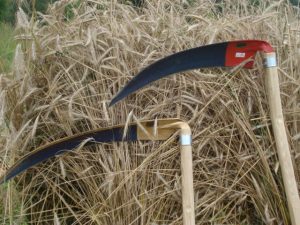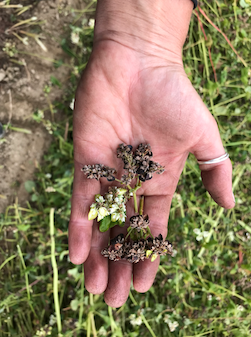Why Ancient Grains?
At Naga Bakehouse we are working to reconnect to the ancient practices of baking with heirloom wheat varieties by restoring and renewing our matzah traditions. Today with the resurgence and burgeoning interest in heirloom varieties of grains we have selected emmer as our ancient grain of choice. According to the Heritage Wheat Conservancy, “Emmer sustained early peoples since the dawn of agriculture. In ancient Egypt it was the grain eaten by the Pharohs. It was was used in the original matzah, eaten in ancient times. Emmer is a nutrient-rich, gourmet grain with a nutty, substantial flavor.'” This Passover take a culinary foray into the intriguing taste and texture of old world grains and discover matzah made with emmer. We hope you will begin the journey with us to reclaim our ancient heritage and try a box of our Ancient Grain Vermatzah baked with organically grown Emmer.

Again, the Heritage Wheat Conservancy states that “wheat has been the staple foodcrop of humans for centuries. Today, modern wheats are bred for uniformity and high yield. Nutrition and flavor have been forgotten. The rare heritage wheats that once nourished earlier civilizations are on the verge of extinction. ” Great taste, ancient grains have a distinctive taste and are more flavorful than modern whole grains. Unlike modern grains, ancient grains have survived intact for centuries and remained virtually untouched by modern plant science. Nutritional excellence: Ancient grains are unique because they contain all the major nutrient groups: carbohydrates, proteins, fats, vitamins, and minerals and are often a richer source of nutrients than modern grains because a lack of breeding has left their nutrition profile intact. Health Benefits: People have known about the benefits of whole grains for centuries. Hippocrates said in 400 BC, to the human body, it makes a great difference whether the bread is made of fine flour or coarse, whether of wheat, with the bran, or without the bran. Contact www.growseed.org for more information about Ancient Grains.
Buckwheat
 Its name notwithstanding, the buckwheat plant is a pseudo-cereal—neither grass nor grain—and has nothing to do with wheat. Gluten and grain-free, organic buckwheat flour has more protein, dietary fiber, and B vitamins than an equal weight of oat or whole wheat flour. It is an excellent source of potassium and essential amino acids. If you are an avid omnivore (like us) such details are incidental; you’ll fall in love with buckwheat for its robust, earthy, hoppy flavors, rounded out with hints of rose. We also just love how the flour looks—it’s a slate grey brown, flecked with darker specks created by the plant’s hull.
Its name notwithstanding, the buckwheat plant is a pseudo-cereal—neither grass nor grain—and has nothing to do with wheat. Gluten and grain-free, organic buckwheat flour has more protein, dietary fiber, and B vitamins than an equal weight of oat or whole wheat flour. It is an excellent source of potassium and essential amino acids. If you are an avid omnivore (like us) such details are incidental; you’ll fall in love with buckwheat for its robust, earthy, hoppy flavors, rounded out with hints of rose. We also just love how the flour looks—it’s a slate grey brown, flecked with darker specks created by the plant’s hull.
Vermatzah: Sustenance For The Body; Fuel For The Soul
